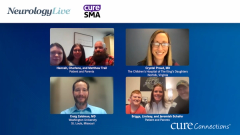
Experiences with Telehealth for Pediatric Patients with SMA
Two pediatric neurologists describe their experiences with telehealth appointments for SMA during the COVID-19 pandemic.
Episodes in this series

Crystal Proud, MD: I’d like to shift gears a little and talk about our experiences with telehealth. In this era of COVID-19, telehealth is frequently utilized to deliver care. I have spent a lot of time on Zoom in particular doing telehealth visits. Dr Zaidman, what has your experience been with utilizing a telehealth platform with regard to patients with SMA [spinal muscular atrophy] the past couple of years?
Craig Zaidman, MD: It’s hard to give hugs. That’s a big bummer about it. I like to give hugs. Briggs, you might not know that about me yet, but it’s coming, buddy. That part is hard. Dr Proud, I want you to talk about the logistics of this. My personal practice and your practice are different. We see different patients, so I’ll let you take some of the details of how to do it. But my rule is that, if possible, I like to have an initial office visit in person. I can explain why. Briggs, or mom and dad, do you remember anyone ever checking Briggs’ reflexes and commenting that they couldn’t elicit any reflexes?
Lindsay: Yes. The physical therapist did. That was the first time anyone had ever checked, besides his normal maintenance well visits. I don’t know if it was missed, but our doctor did check them. I don’t know if he still had them. That’s a question. If you’re born with SMA, do you ever have any reflexes?
Craig Zaidman, MD: It’s very unlikely. I have some patients who do have reflexes, so it’s possible that Briggs had them and lost them. But especially for Briggs, his story is a little harder to pin down in terms of when you noticed it and it taking so long to get the diagnosis. To diagnose Briggs would’ve required checking his reflexes. In fact, that’s how we made the diagnosis and why I suspected it when I met him. The way in which Briggs walks doesn’t say, “This is spinal muscular atrophy.” The way in which he walks says that he’s weak, but it doesn’t tell me more than that.
I like to see my first patients, my initial office visit, in person because it allows me to come up with the best diagnostic plan, and that ultimately saves time. If you have a patient who you’re suspecting has SMA—I’m sure we’ll talk about this, Dr Proud—you can do 2 things at once. You can get on the list for an office visit with a doctor like me, and you can send a genetic test while that’s pending. When I have a newborn baby identified with SMA, I like to see them in person, too. Although, it’s such an emergency that I’d be willing to do it over telehealth if there was no other option. Dr Proud, how do you do your telehealth appointment? How do you set them up for that?
Crystal Proud, MD: Like you, I balance a combination of telehealth and in-person visits. When it’s a new patient and we’re considering any nerve and muscle diagnosis—for example, if the patient is calling to schedule a visit and the reported issue is weakness, difficulty walking, tripping, and falling—I’d prefer to see that patient in person, just like you. Because, as a neuromuscular specialist, we’re trained in how to assess muscle strength, look at reflexes, watch you walk down the hall, and watch you perform some tasks. We can do some of those over video, but with some of them we can’t, like checking reflexes. If we can pursue that initial visit in person, it’s also my preference.
Once we have an established relationship, we have the option of pursuing follow-up visits with telehealth. That also depends on what’s needed. For example, Hannah is on a medication that requires that I send updated assessments to her insurance to justify authorization for her to continue on that treatment. And while my physical therapist and occupational therapist could certainly pursue a portion of those assessments over telehealth, they’re best done in person in our specially designed assessment room that we have in clinic with the tools that they utilize. That allows us to have a very accurate assessment of Hannah’s motor function that I can use to validate why I’m continuing her on the treatment that I know works so well for her.
We can do some visits back and forth where maybe some are in person and some are telehealth, depending on what’s needed. If it’s time for reauthorization of medicine and it’s been the duration of time that the insurance demands, we’re probably having an in-person visit. If the percentage positivity of COVID-19 patients is incredibly high and we aren’t due for a reauthorization and we have other things that we can discuss over telehealth, [such as] migraines, attention, school, mood, or diet, then telehealth works quite well for that as well. Hannah, what are your thoughts on your experience with telehealth? We’ve had a few visits where we’ve done it over the computer like this.
Hannah: It’s been helpful where I don’t have to miss a ton of school, but I also like to see you in person.
Crystal Proud, MD: I like to see you in person, too. But you’re right. We’ve had a more urgent visit on telehealth, too. It was the quickest way to be able to chat. Sometimes it can be very convenient as well at getting access to each other more quickly.
Transcript edited for clarity.
Newsletter
Keep your finger on the pulse of neurology—subscribe to NeurologyLive for expert interviews, new data, and breakthrough treatment updates.
































